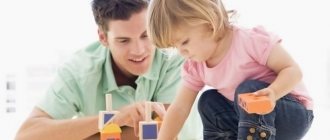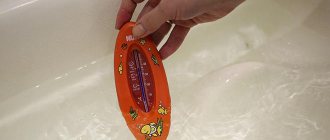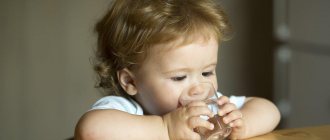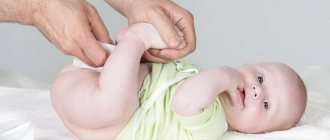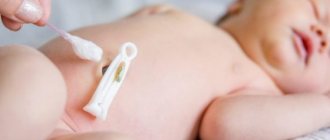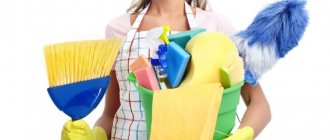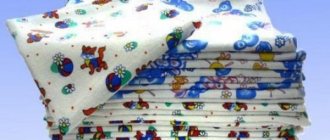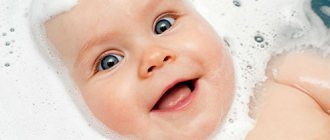Proper skin care is very important from early childhood, and healthy skin in childhood is the key to healthy skin in the future. The protective properties of the skin and the entire immune system are still immature. Therefore, a child needs good care and impeccable cleanliness in everything that surrounds him. Already from the newborn period, the hygiene of girls and boys has its own similarities and differences.
Basic hygiene procedures for a newborn include daily bathing in a baby bath, daily facial skin care, toileting the eyes, ears, washing girls and boys.
Let's talk about swimming first.
Daily bathing not only keeps the body clean, but also stimulates skin functions, blood circulation, and develops the child’s nervous system and psychophysical motor skills.
To bathe your baby, you need to prepare : a baby bath, a jug or ladle for rinsing, a thermometer for water, a soft terry mitten for soaping, a towel or sheet, pieces of cotton wool, a clean diaper, baby hygiene products, clean baby linen.
It is better to bathe your baby at the same time before one of the evening feedings. Make sure that the room where you will bathe your child is warm, without drafts, the water has a temperature of 37-37.5 ° C. The first bath should be carried out very carefully, immersing the baby’s body in the bath, always supporting it with your hand so that the baby does not slip out. Wash with your other hand, avoiding getting soap on your face and eyes, especially when washing your hair. It is enough to wash the head once or twice a week.
The bathing process should last 5-7 minutes. The child should be rinsed from a ladle with water at the same temperature.
After the first month of life, you can gradually reduce the water temperature by one degree. Remember: frequent use of baby soap when bathing can cause dry skin. If a child has a crust on the umbilical wound, add a 5% solution of potassium permanganate to the water (until it turns slightly pink). For skin irritation, you can add chamomile infusion or oak bark decoction to the water. After bathing, the baby’s body should not be rubbed, but blotted with a soft towel or sheet. Then lubricate the skin folds with baby lotion, baby cream or sterile sunflower oil.
In addition to bathing, the child needs to carry out hygiene procedures daily.
Wash your face, starting with the eyes. To do this, use a piece of sterile cotton wool soaked in warm boiled water. A separate cotton swab is used for each eye to prevent possible transmission of infection. The eyes are washed from the outer corner to the inner. The nasal passages are cleaned with cotton wool, also soaked in boiled water. It is necessary to wipe off the yellow-orange discharge that accumulates in the visible part of the ear with a cotton swab with a limiter. Fingernails and toenails should be trimmed as they grow.
It must be remembered that girls and boys are washed differently .
Morning hygiene for infants
In the morning, when the baby wakes up, he needs to wash his eyes, clear the nasal passages of accumulated mucus, and wash. Before starting manipulations, mother needs to wash her hands with soap. A long manicure will greatly interfere with caring for a newborn baby. In addition, the baby can be accidentally injured . Therefore, nails should be cut short and the corners filed.
Hygiene items required for procedures are laid out on the changing table.
Morning eye hygiene
You need to pour boiled water into a clean small container, roll up cotton swabs in advance or stock up on sponges (cotton pads). Pieces of cotton wool are not suitable for such a scrupulous process. They leave behind lint on the child’s eyelashes, which can get into the eyes and cause discomfort.
A swab soaked in water, wring out a little, and wipe the eyes from the outer edge to the nose. Each eye requires its own separate swab, which is immediately discarded after use.
If a newborn baby accumulates a lot of discharge, you can use a decoction of herbs or weak tea leaves for eye hygiene.
Hygiene of the nasal passages of a newborn
Crusts and mucus accumulate in the baby's nose overnight, preventing him from breathing freely. Under no circumstances should it be removed with cotton swabs. This is extremely dangerous for the child . At any time when cleaning your nose, it can twitch, turn, sneeze and get injured. For the procedure, thinly wound cotton tubes (flagella) with a long tail, soaked in baby oil, are used. You can use ordinary vegetable oil rather than pharmaceutical oil. It is boiled in a water bath for 20 minutes. To care for a baby, 100 g is enough for a whole month.
The tube is carefully inserted into the nostril with screwing movements, and immediately taken out. When rotated, the cotton wool collects mucus and moistens the frozen crusts. They are removed using a new tube soaked in oil. There is no need to insert the flagellum deeply. A separate flagellum is used for each nostril. If you cannot get rid of the crusts, you can soften them by adding drops based on sea salt. They are hypoallergenic and non-hazardous.
Additionally : Read more about cleaning the nose of babies - read in detail here
Ear hygiene
You only need to clean the newborn's ear. The ear canal is not touched during treatment - it is very vulnerable. Any careless movement can lead to serious consequences for the child. It is better to clean your ears with sponges moistened with warm water.
Facial hygiene
The face of a newborn baby is wiped with sponges soaked in boiled warm water, close to the baby’s body temperature, so that he is not afraid. Be sure to wipe the baby’s forehead, chin and cheeks.
Everyday hygiene procedures after sleep include washing the butt and genitals. The procedure is carried out using warm water. The body is carefully wiped and lubricated with cream or powder. It is not recommended to use wet wipes for these purposes. They cause an allergic reaction and do not completely remove dirt. You can use a napkin only in an emergency, when mother and baby are away from home - a list of wet wipes for a newborn.
Processing folds
Wipe the folds with a sponge lightly dipped in oil. Be sure to pay attention to all places, including the folds behind the ears. Remnants of epithelium, villi and cream, which are used to lubricate the baby, often accumulate there.
Treatment should begin with the head: first the ears, then the neck, armpits, arms, palms, interdigital spaces, inguinal and popliteal folds. It is advisable to change tampons regularly. You only need to lubricate the folds, but not the entire body of the child. Oil worsens the respiratory function of the baby, clogs pores, and provokes inflammatory processes.
Additionally: Article about the treatment of skin folds in a baby
Special care for the navel
To do this, there should be cotton swabs, sponges, 40% alcohol, pharmacy 3% hydrogen peroxide, and a pink solution of potassium permanganate on the changing table. Not all doctors recommend using brilliant green, since the navel swells under it.
The sticks are soaked in peroxide and the navel, slightly spread apart with your fingers, is moistened. It is advisable to wait until the peroxide reacts, bubbles and softens the crusts. Then use a cotton swab to remove the remaining peroxide and crusts. Wipe the wound again with a clean cotton swab dipped in alcohol. Dry the navel and lubricate it with potassium permanganate. It is necessary to dilute potassium permanganate daily, as it is destroyed in the light.
There is no need to lubricate the area around the navel with an antiseptic. If the color of the skin around it has changed or redness has appeared, you should immediately see a pediatrician. Often the belly button heals within one week. Slight bleeding from the wound at this time is considered normal.
Additionally: Proper care of the umbilical wound of an infant
How to wash a girl:
- Remove used diapers and diapers. Remove fecal residue from your baby's skin using moistened baby wipes or damp gauze. Thoroughly wipe the perineal area with a piece of cotton wool and baby lotion.
- Using another piece of cotton wool with lotion (or simply soaked in warm boiled water), carefully wipe all the folds in the groin areas. To remove remaining moisture, use baby powder - pour a little into your palm and spread evenly over the baby's skin (do not apply directly to the body).
- Raise your baby's legs and use a clean piece of cotton wool to wipe the genitals from front to back to prevent germs from moving from the anus to the perineum. You should NOT wipe the inside of your labia.
- Wipe the anus with a clean piece of cotton wool. To remove excess moisture from your buttocks, also use baby powder. Wash your hands afterwards.
- In order to protect your child's skin from various irritations and rashes, use baby cream. Baby oil will also prevent skin irritation and dryness.
- The girl is always washed by directing the stream of water from front to back. Sometimes a girl experiences mucous or bloody discharge from the genital opening. This is the body’s reaction to releasing it from maternal hormones. If a girl has discharge from the genitals, she should be especially thoroughly washed with a weak pink solution of potassium permanganate or a weak solution of chamomile. Wash it several times a day and always after stool.
Child care during the day
Newborn hygiene does not only consist of mandatory morning procedures. The child needs to be looked after all day. After feedings, the area around the lips is wiped with a damp swab or sponge. Residues of milk or formula irritate the baby’s delicate skin, and various rashes appear on it.
Nail hygiene
Many new mothers are terrified of trimming the nails of their newborn babies for fear of hurting their tiny fingers. You can cope with this task easily and quickly using several recommendations:
- You need to buy scissors with rounded ends or special tweezers designed for newborns. They have a built-in magnifying glass that allows you to clearly see the nail. Using such a tool, you can safely begin the pruning process.
- Experienced mothers know that it is better to cut a newborn’s nails when he is sleeping soundly. The baby will not feel anything, and will not twitch at the most inopportune moment.
- You need to trim your nails regularly, paying attention to the edges. They grow back quickly, and the baby may accidentally scratch his face or stomach, since he is not yet able to control himself.
Additionally: See the article about nail treatment for babies -
Washing
The child should have individual hypoallergenic soap, clean napkins and a towel. Wash babies after each diaper change. Hygiene for a newborn girl is slightly different from washing a boy. When washing the genitals, you must adhere to the following rule: rinsing movements are made from the front back towards the anus. Residues of feces should not get on the mucous membrane, otherwise inflammation will occur. For the same reason, it is better to wash girls in a sink under running water, rather than in a basin.
There is no need to intensively soap, rinse and wipe the baby’s labia. This can provoke the development of synechia - fusion of the labia due to injury to the mucous membrane due to constant contact of the genitals with a towel and soap. After rinsing, the genital slit is blotted with a soft diaper, then the labia, inguinal folds and anus are wiped.
The vaginal mucosa of newborn girls is extremely sensitive. Therefore, you need to use hypoallergenic hygiene products. It is prohibited to wipe the labia from the inside. This can lead to infection and inflammation. At first, the baby may experience bleeding from the vagina. They pass quickly without requiring special treatment. You should immediately contact a pediatrician if there is redness of the labia, purulent-bloody or purulent-mucous secretion with an unpleasant odor. The child should have other secretions other than natural white mucous.
Boy hygiene includes washing the penis, scrotum and anus with warm running water. Afterwards, the child’s body is dried, lubricated with cream, treated with liquid talcum powder or powder. See our tips for cleaning
Bathing
Bathing your child becomes the most important ritual before bedtime. This procedure cannot be ignored. In the first month, the newborn should be bathed every day, then, if it is a cold season, bathing can be done every other day. It cleanses the skin of toxins, epithelial residues, and sweat. Warm water has a calming effect on the baby, since he spent 9 months in this environment before birth. After the washing procedure, the baby will sleep peacefully and for a long time.
First you need to choose a room. If the bathroom is uncomfortable, you can bathe your newborn in the room. To do this, close all windows and doors, eliminate drafts, and turn on the heater if necessary so that the air is not too cold and the baby does not catch a cold.
For bathing you need a bathtub, water heated to 37 degrees, a thermometer to measure the water temperature, hot water to regulate the warmth of the water in the bath, warm water in a rinse bucket, a diaper and a soft large towel. The newborn is first wrapped in a thin diaper so that he is not afraid of water. The baby’s legs are lowered into the filled bath, gradually pouring a little onto the chest and back from a ladle.
Then they carefully dip the whole body and make sure that no water gets into the eyes and ears. To prevent the baby's head from accidentally being under water, bathing should be carried out by two adults. One will hold the head, the other will carefully water it in a thin stream and wash it. When the baby gets used to the water, the diaper is removed.
The first time the bathing process lasts no longer than 7 minutes. Later the time is increased to 15 minutes. For washing, you can use special hygiene products for a newborn - shampoo that does not irritate the eyes and baby soap. At the end of the procedure, the baby is washed from the ladle, wrapped in a diaper, and then in a towel. When the water is absorbed, the baby is lightly wiped off drops of water. The groin area, folds, eyes, nose and umbilical wound are treated.
Useful to read:
- First bath of newborns - what needs to be prepared;
- Using various herbs for bathing.
How to wash a boy:
- When removing used diapers, pause for a few seconds - this is when boys often urinate. Remember that outdoors a boy may urinate several times in a row, so keep a special diaper on hand so you don't have to repeat the whole procedure all over again.
- Remove any remaining discharge from your baby's skin using moistened baby wipes or damp gauze, then wipe the entire area with a piece of cotton wool and baby lotion.
- Using another piece of cotton wool with lotion or soaked in warm water, carefully wipe all the folds in the groin areas and around the genitals. Then use powder to remove excess moisture, especially around the testicles.
- Using a clean cotton swab soaked in warm water, wipe the testicles and penis to remove any remaining urine or feces. Be careful not to damage the delicate skin. When cleaning your penis, DO NOT peel back the skin on the head.
- Wipe the anus and buttocks with a clean piece of cotton wool with lotion or soaked in warm water. Don't forget to wash your hands afterwards.
- In order to protect the skin from irritation and rashes, apply baby cream to the entire cleaned area - around the penis (but not on the penis itself), testicles, buttocks. After the baby has been undressed for a while, you can put a clean diaper and wrap the baby in clean diapers.
Some children have visible discharge from their nipples, both boys and girls. They may have enlarged or swollen breasts. No treatment is needed as this condition will go away on its own. However, if you notice any redness in the swollen areas, notify your doctor.
The use of disposable diapers is an effective way to isolate and contain urine and stool. Diapers help keep the baby's skin drier, reduce the incidence of diaper dermatitis, are comfortable for the baby, practical and easy to use. Reports that the use of disposable diapers for boys creates an unfavorable diaper climate, has a negative impact on testicular infrastructure and suppresses spermatogenesis, has no scientific evidence and is purely speculation and speculation.
When choosing diapers, you need to take into account the weight of the child. If the diaper is too big, it will leak. Disposable nappies should be stored in a cool, dry place as increased humidity can have a negative effect on the moisture-absorbing material of the nappies.
Lyudmila Ponomareva, Doctor of Medical Sciences, Professor Article from the newspaper
Baby hygiene products for babies
Baby hygiene involves the use of special products for caring for small children. Required tools:
- bar of baby soap;
- liquid talc, which neutralizes moisture and does not clump;
- mild shampoo labeled “no tears”;
- cream or ointment for redness, rashes, irritations and rashes - Bepanten, Panthenol, Desitin.
When buying hygiene products for a child, it is advisable to look at the expiration date, quality of the product, integrity of the packaging and composition. It’s easy to determine which products are high-quality and which are not. The label will indicate the manufacturer, list the composition, instructions for use, written without errors or typos.
Content
- 1 Relevance
- 2 Skin care for a newborn baby
- 3 Bathing a newborn
- 4 Hair care for a newborn baby
- 5 Combing a baby
- 6 Newborn baby's navel
- 7 Caring for the eyes, ears and nose of a newborn
- 8 Hygiene and nail care for a child under one year old
- 9 Hygiene and dental care for a newborn baby
- 10 Washing and air baths
- 11 Use of disposable diapers
- 12 Links
Baby skin care
Baby's skin is very delicate and prone to irritation. In order to avoid problems, you need to carefully care for it. When a child has clean skin, no diaper rash, no rashes, the newborn feels comfortable, sleeps well and is not capricious. Make sure that in summer your baby's skin is not exposed to direct sunlight (sunscreen can only be used from 6 months of age). During the winter, make sure that your newborn is warm and the skin surfaces are covered as much as possible. Indoors, you can use a humidifier in winter to keep the indoor air moist. However, this device must be kept clean to prevent mold from forming and spreading in the air.
When caring for the healthy skin of a newborn, you should avoid any actions that could damage it (exposure to high humidity, friction, irritants and toxic substances). A decrease in the protective properties of the skin is facilitated by frequent and unjustified degreasing (with alcohol, ether), cooling, and irritation of the skin with urine and feces.
Caring for your newborn's eyes, ears and nose
Thanks to modern technologies and innovations, modern parents do not need to make cotton or gauze swabs themselves. To clean the nose and ears, pharmacies sell special devices, turundas.
We start every morning by washing the newborn's eyes with a damp swab dipped in water. We treat each eye separately in the direction of self-cleansing, that is, from the temple to the nose.
If mucus has accumulated in the baby’s nose, then we use dry turunda. When crusts appear in the nose, first moisten the turunda with oil to care for the child’s skin. It is advisable to take the oil purified and without fragrances. When cleaning the spout, perform manipulations carefully and carefully, and your movements must be clear.
It is recommended to clean your ears after an evening swim, removing excess moisture and making the process less painful.
Circumcision and genital care
Circumcision is a procedure that removes a fold of skin from the head of a boy's penis called the foreskin. Whether or not to circumcise is always the choice of the parents. In addition to assessing the potential medical benefits and risks, cultural, religious or ethnic backgrounds that may influence the decision should also be taken into account. The following information can help you make an informed decision:
Circumcision of the foreskin in boys has a number of advantages:
- A 10-fold reduction in the risk of bladder infection in the 1st year of life.
- Slightly reduced risk of developing penile cancer in adulthood.
- Slight reduction in the risk of sexually transmitted infections, including HIV.
- Simplification of genital hygiene and prevention of infection under the foreskin.
- However, it is necessary to understand the possible risks:
- Risk of bleeding, infection and improper healing.
- A circumcision that is too short or too long may require repeat surgery.
- After the foreskin is removed, the tip of the penis may become irritated and the opening of the urethra may become swollen and narrowed.
Oral care
Although your newborn baby does not yet have teeth, it is still necessary to immediately begin to take care of his oral cavity. Some newborns are born with one or two teeth (like Napoleon Bonaparte or Elizabeth of Austria). If this applies to your child, be sure to brush their teeth with a soft baby toothbrush. Do this twice a day: after the first and last feeding. Toothpaste is not needed for children under six months of age, and using it may result in a fluoride overdose.
If a white coating appears in your baby’s mouth (a possible sign of candidiasis), you should consult a doctor.
Caring for an Uncircumcised Penis
You should carefully wash your penis with soap and warm water by hand while bathing your son. You don't need to use cotton wool, cotton pads or gauze to clean it. Don't forget to wash the scrotum and area under the scrotum.
Never pull back the foreskin to clean the head of the penis! Over time, the foreskin will begin to retract on its own: this happens at different times for different children, but most boys can retract their foreskin by age 5. When this happens, teach your son penile hygiene: wash the head of the penis daily with soap and warm water, pulling the foreskin back.
Using disposable diapers
Modern diapers effectively isolate and retain urine and feces, helping to keep the skin dry, reduce the incidence of diaper dermatitis, and are comfortable to use. However, choose diapers, paying attention to the material from which they are made and consider the weight of the child. If you put a large diaper on your baby, it is bound to leak. Store pre-purchased diapers in a cool, dry place.
Begin to develop toilet skills at the level of conditioned reflex activity from the moment the child masters sitting skills. Full use of skills such as using a potty or toilet ends around age four.
To summarize, it is clear that even before the child is one year old, certain rules of personal hygiene can be formed.
Author: Anna Kompaniets
